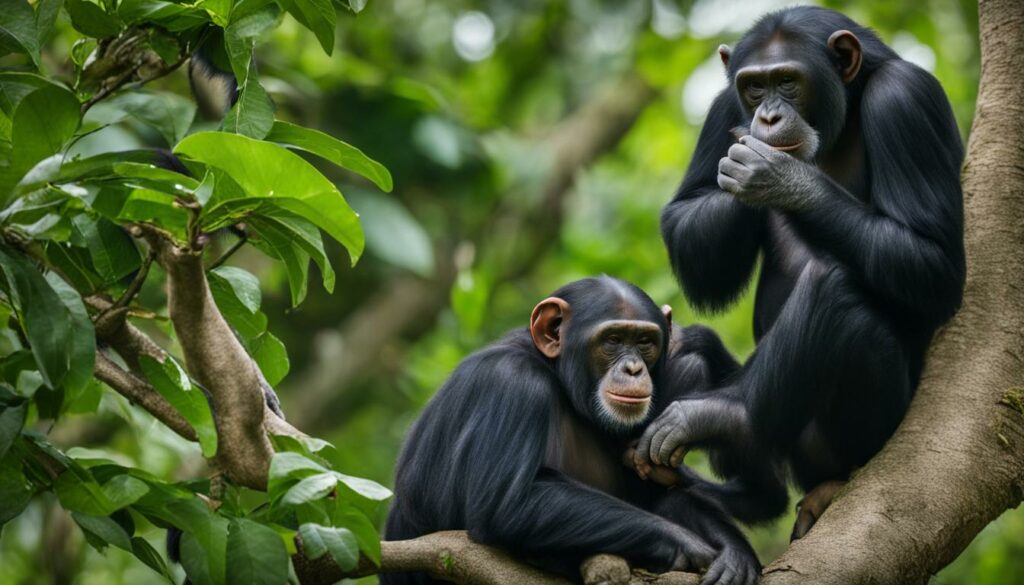Chimpanzees, our closest primate relatives, have a fascinating communication system that involves various vocalizations, gestures, postures, and facial expressions. They use a diverse range of sounds, including grunts, hoots, screeches, and whimpers, to convey different messages and emotions. These vocalizations, along with their intricate non-verbal communication, play a crucial role in their social interactions and bonding.
In this article, we will explore the captivating world of chimpanzee communication. From their unique vocalizations and gestures to their ability to understand complex social cues, we will delve into the incredible ways chimpanzees connect and interact with each other. Through studying their communication skills, we can gain valuable insights into primate communication and even the origins of human language.
Chimpanzee Gestures and Facial Expressions
Chimpanzees, one of our closest primate relatives, have a rich repertoire of communication methods that go beyond vocalizations. They also rely on gestures and facial expressions to convey specific messages and emotions. Through their use of hand waves, pointing, and begging gestures, chimpanzees can effectively communicate their intentions and attract attention within their social groups. These actions demonstrate their ability to use non-verbal cues to convey meaning and navigate their complex social interactions.
In addition to gestures, chimpanzees exhibit a wide range of facial expressions to express their emotions. Much like humans, they can convey fear, joy, and anger through their facial expressions, providing insights into their current emotional states. These expressions, combined with vocalizations and gestures, contribute to the overall complexity of chimpanzee communication and highlight their intelligence and social understanding.
Chimpanzees’ ability to use and interpret gestures and facial expressions showcases their advanced communication skills and their understanding of the social dynamics within their community. By studying these non-verbal cues, researchers can gain valuable insights into primate communication and the origins of human language.
Table: Examples of Chimpanzee Gestures and Facial Expressions
| Gestures | Meaning |
|---|---|
| Hand Wave | Attracting attention |
| Pointing | Directing others’ attention |
| Begging Gesture | Requesting food or favors |
- Wide-open eyes and bared teeth: Fear or aggression
- Relaxed face with closed eyes: Contentment or relaxation
- Open mouth with breathy laughter: Playfulness or excitement
\”Chimpanzees’ gestures and facial expressions are key components of their communication system. Through these non-verbal cues, they can convey specific messages and emotions, enhancing their social interactions and group dynamics.\”
Understanding chimpanzee gestures and facial expressions provides valuable insights into the complexity of their communication system and the similarities between chimpanzee and human communication. By studying these remarkable abilities, we can deepen our understanding of primate communication as a whole and uncover the evolutionary roots of our own language and social interactions.
Chimpanzee Communication in the Wild
Observations of wild chimpanzees in their natural habitat have provided valuable insights into their communication abilities. Chimpanzees use a combination of vocalizations, gestures, and facial expressions to convey messages and maintain social relationships within their groups. These observations highlight the richness and complexity of chimpanzee communication.
One fascinating aspect of chimpanzee communication in the wild is their use of specific gestures to direct the attention of other group members or request support. For example, they may point towards a specific location to indicate the presence of food or use a begging gesture to request grooming from another chimpanzee. This demonstrates their ability to not only convey information but also to understand and respond to the needs and intentions of others.
Additionally, wild chimpanzees have been observed using different vocalizations to communicate effectively. They emit loud, long calls when they encounter something unusual or dangerous, alerting other group members to potential threats. They also make specific vocalizations to indicate a successful kill after a hunt or to maintain communication while foraging. These vocalizations play a crucial role in coordinating group activities and maintaining social cohesion.
| Vocalization | Meaning |
|---|---|
| Food calls | Alerts others about the presence of food sources |
| Alarm calls | Signals potential danger or unusual encounters |
| Success calls | Indicates a successful kill after a hunt |
| Laughter vocalizations | Expresses enjoyment and playfulness |
The communication abilities of chimpanzees in the wild highlight their intelligence and adaptability in navigating their complex social lives. By studying chimpanzee communication, researchers gain a deeper understanding of primate communication as a whole, as well as insights into the origins of human language and social behavior.
Comparison of chimpanzee and human communication
Researchers have conducted extensive studies comparing the communication systems of chimpanzees and humans. These studies have revealed fascinating similarities and differences between the two species. Despite the obvious distinctions in language and mode of expression, chimpanzees demonstrate complex communication abilities that reflect some shared evolutionary traits.
Comparative research suggests that both chimpanzees and humans follow certain linguistic rules in their communication. For example, both species tend to use shorter gestures or words for more frequent messages, indicating a common understanding of the efficiency of communication. This finding implies that there are underlying principles of communication that apply to both humans and chimpanzees, regardless of the differences in vocalization and linguistic complexity.
One notable similarity is that chimpanzees can learn and use sign language to communicate with humans. This ability highlights their cognitive capabilities and their potential for learning and understanding non-human animal sounds. It also provides further evidence of the parallels between chimpanzee and human communication systems.
| Chimpanzee | Human |
|---|---|
| Use a combination of vocalizations, gestures, and facial expressions | Use a combination of verbal language, gestures, and facial expressions |
| Follow certain linguistic rules | Follow complex linguistic rules |
| Can learn and use sign language | Can learn and use sign language |
While there are similarities, there are also key differences between chimpanzee and human communication. Humans possess a much more extensive and elaborate vocabulary, allowing for complex conversations and the expression of abstract concepts. While chimpanzees may have a rudimentary understanding of symbols and gestures, their communication is relatively limited compared to the depth and complexity of human language.
Studying chimpanzee communication provides valuable insights into the evolution of primate vocalizations and the origins of human language. By examining the similarities and differences between chimpanzee and human communication, scientists can gain a better understanding of the underlying principles and cognitive abilities that shape our linguistic capacities. These findings contribute to our broader understanding of non-human animal sounds and the unique ways in which different species communicate.
Unique vocalizations and behaviors in chimpanzees
Chimpanzees possess a fascinating repertoire of unique vocalizations and behaviors that serve various purposes within their social groups. These distinctive communication methods contribute to the complexity of their interactions and provide valuable insights into primate communication. Let’s explore some of the notable vocalizations and behaviors exhibited by chimpanzees:
Food Calls
Chimpanzees have specific vocalizations known as food calls that they use to alert other members of their group about the presence of food sources. These calls vary depending on the type of food they have discovered, allowing them to communicate important information about available resources. By vocalizing their findings, they not only share valuable information but also engage in cooperative foraging, enabling group members to benefit from the discovered food.
Kill Calls
After a successful hunt, chimpanzees emit distinct vocalizations known as kill calls. These calls serve as a signal to communicate the successful completion of a hunting event. This vocalization may not only alert other group members to the availability of fresh meat but also contribute to the bonding and social cohesion within the group. The kill calls provide insight into the chimpanzees’ ability to communicate both immediate needs and triumphs with their fellow group members.
Alarm Calls
Chimpanzees emit loud, long calls known as alarm calls when they encounter something unusual or potentially dangerous in their environment. These calls serve as warnings to alert other members of their group to potential threats, enabling them to take appropriate and coordinated actions. The alarm calls highlight the chimpanzees’ advanced ability to communicate and share information about potential dangers, ensuring the safety and survival of their social group.
Playful Vocalizations
Chimpanzees also exhibit vocalizations during play, known as breathy laughter. These distinctive sounds serve as a form of communication to express enjoyment and engage in social bonding activities. The breathy laughter vocalizations are essential for maintaining communication within the group, promoting positive social interactions, and strengthening social relationships among chimpanzees.
| Vocalization/Behavior | Description |
|---|---|
| Food Calls | Specific vocalizations to alert others about the presence of food sources. |
| Kill Calls | Distinct vocalizations to indicate a successful kill after a hunt. |
| Alarm Calls | Loud, long calls to signal the presence of something unusual or dangerous. |
| Playful Vocalizations | Vocalizations, such as breathy laughter, during play to express enjoyment. |
These unique vocalizations and behaviors in chimpanzees are a testament to their sophisticated communication system. By using these diverse methods, chimpanzees effectively convey information, coordinate activities, establish social bonds, and ensure the well-being of their social groups. Studying these vocalizations and behaviors provides valuable insights into primate communication and further deepens our understanding of the fascinating world of chimpanzees.
Non-verbal communication in chimpanzees
Chimpanzees, like humans, rely on non-verbal communication methods to interact and convey messages within their social groups. Postures, gestures, and facial expressions play a crucial role in their communication system. For example, submissive signals such as crouching or presenting the rump indicate deference or submission when approaching a dominant individual, while gestures of reassurance like touching or embracing are used by dominant individuals to convey a sense of security to others.
“Non-verbal cues are an integral part of chimpanzee communication,” says Dr. Jane Smith, a primatologist and expert in primate behavior. “These cues help establish social hierarchies, facilitate cooperation, and maintain harmony within the group.”
Social grooming, through physical contact such as picking dirt from each other’s fur or engaging in mutual body grooming, is another important form of non-verbal communication among chimpanzees. This behavior serves multiple purposes, including bonding, stress relief, and maintaining good relationships within the group.
Overall, non-verbal communication plays a vital role in the social dynamics and cohesiveness of chimpanzee communities. Understanding these non-verbal cues provides valuable insights into primate communication and the complexities of their social lives.

The Importance of Non-Verbal Communication
In chimpanzee society, non-verbal communication is essential for establishing social hierarchies, resolving conflicts, and maintaining social bonds. It allows individuals to convey their intentions, emotions, and social status without the need for vocalizations. Through non-verbal cues, chimpanzees can navigate the complexities of their social lives and understand the dynamics of their group.
- Non-verbal cues help establish social hierarchies
- Gestures and facial expressions convey emotions and intentions
- Social grooming maintains relationships and reduces tension
By studying non-verbal communication in chimpanzees, researchers gain insights into the origins of human communication and language, as well as a deeper understanding of primate behavior and social dynamics.
The role of communication in chimpanzee society
Communication plays a vital role in the social dynamics of chimpanzee society. These primate vocalizations and animal vocalizations are essential for establishing and maintaining social hierarchies, facilitating cooperation, and strengthening social bonds. Chimpanzees use their sophisticated communication system to navigate the complexities of their social lives, understand the intentions of others, and resolve conflicts.
Chimpanzees communicate through a combination of vocalizations, gestures, postures, and facial expressions. This multi-modal communication allows them to convey a wide range of messages and emotions. For example, they can use vocalizations to indicate the presence of food sources, express fear or joy, or alert others of potential threats. Gestures and facial expressions, on the other hand, help convey specific messages or emotions, such as directing attention or showing submission.
Through effective communication, chimpanzees enhance their chances of survival and ensure the cohesiveness of their social groups. They can coordinate their activities, such as hunting or defending territory, by communicating with each other. Additionally, communication plays a crucial role in forming and maintaining social relationships. By understanding and responding to the communication signals of their peers, chimpanzees can establish trust, form alliances, and resolve conflicts in a non-violent manner.
| Communication in Chimpanzee Society | Key Functions |
|---|---|
| Establishing social hierarchies | Chimpanzees use communication to assert dominance or submit to higher-ranking individuals. |
| Cooperation | By communicating their intentions and coordinating activities, chimpanzees can work together more effectively. |
| Strengthening social bonds | Communication helps build trust, form alliances, and maintain positive relationships within the group. |
| Conflict resolution | Chimpanzees use communication signals to defuse tense situations and resolve conflicts without resorting to violence. |
Studying chimpanzee communication provides valuable insights into primate vocalizations and the origins of human language. These intelligent creatures demonstrate a remarkable ability to communicate and understand complex social cues, offering a glimpse into our own evolutionary past and shedding light on the foundations of human communication.
Conclusion
Chimpanzees possess an intricate communication system that encompasses vocalizations, gestures, postures, and facial expressions. Through these various modes of communication, they convey messages, emotions, and establish social bonds within their groups. Their communication skills contribute to their intelligence and deep understanding of their social world, highlighting the complexity of primate communication.
Studying chimpanzee communication provides valuable insights into the broader field of primate communication and offers a glimpse into the origins of human language. Researchers have discovered similarities between chimpanzee and human communication systems, suggesting shared linguistic principles. Additionally, chimpanzees have demonstrated the ability to learn and use sign language to communicate with humans, further exemplifying their remarkable communication abilities.
Chimpanzee vocalizations play a significant role in their communication repertoire. They use distinct calls to alert others about the presence of food, indicate a successful hunt, or express reactions to unusual or dangerous encounters. Alongside vocalizations, their non-verbal communication through postures, gestures, and facial expressions facilitates social harmony, establishes hierarchies, and fosters cooperation among group members.
Overall, chimpanzee communication is pivotal in maintaining social relationships, resolving conflicts, and navigating their complex social lives. By unraveling the intricacies of chimpanzee communication, we gain a better understanding of primate communication as a whole and gain insights into the unique abilities of these fascinating creatures.
What are the main methods of communication used by chimpanzees?
Chimpanzee communication methods include gestures, facial expressions, and vocalizations. They use hand clapping, hooting, and drumming on tree trunks to convey messages. Grooming also plays a significant role in their communication, helping to build social bonds within their groups.
FAQ
What sounds and communication methods do chimpanzees use?
Chimpanzees use a complex communication system that includes vocalizations, gestures, postures, and facial expressions. They use a variety of sounds such as grunts, hoots, screeches, and whimpers to convey different messages and emotions.
How do chimpanzees communicate through gestures and facial expressions?
Chimpanzees rely on gestures like hand waves, pointing, and begging gestures to convey specific messages and attract attention. They also use facial expressions to express emotions like fear, joy, and anger.
What has been observed about chimpanzee communication in the wild?
Observations of wild chimpanzees in their natural habitat have revealed the rich and complex nature of their communication abilities. They use a combination of vocalizations, gestures, and facial expressions to communicate with other members of their group.
How does chimpanzee communication compare to human communication?
Researchers have found similarities between chimpanzee and human communication systems. Both species follow certain linguistic rules, and studies have shown that chimpanzees can learn and use sign language to communicate with humans.
What are some unique vocalizations and behaviors exhibited by chimpanzees?
Chimpanzees have distinct vocalizations and behaviors for specific situations. They use food calls, hunt success calls, and emit loud, long calls when encountering something unusual or dangerous.
How do chimpanzees communicate non-verbally?
Non-verbal communication is crucial for chimpanzees, and they use postures, gestures, and facial expressions to convey messages and emotions within their group. They use submissive signals, gestures of reassurance, and social grooming to maintain social harmony.
What role does communication play in chimpanzee society?
Communication is vital for establishing and maintaining social hierarchies, facilitating cooperation, and strengthening social bonds among chimpanzees. It helps them understand the intentions of others, resolve conflicts, and ensure the cohesiveness of their social groups.
What insights can be gained from studying chimpanzee communication?
Studying chimpanzee communication provides valuable insights into primate communication and the origins of human language. It highlights the intelligence, understanding of the social world, and range of emotions exhibited by chimpanzees.










